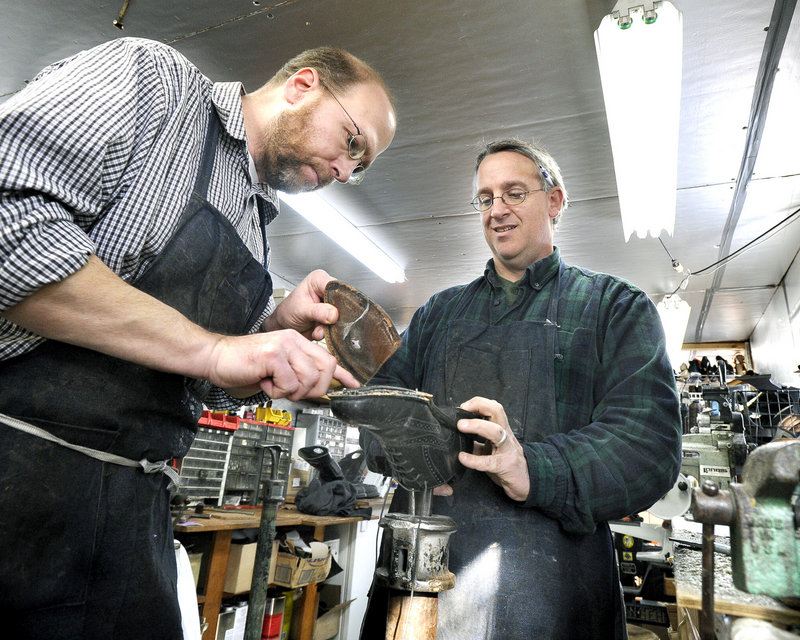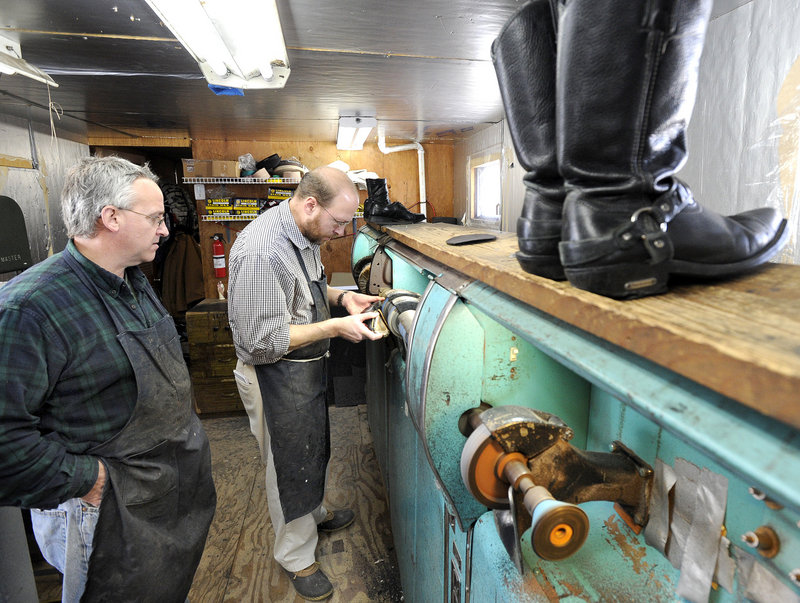WESTBROOK – Paul Rowland handed me a shoe and told me to grind off the old sole. Then he pointed to a grinding wheel — with some very coarse sandpaper spinning incredibly fast — and told me not to take it lightly.
“You want to put some pressure on the shoe, but hold the shoe high, because if you don’t, it can grab that shoe and scrape your knuckles pretty bad,” said Rowland, owner and lone cobbler at Paul’s Shoe Repair on Cumberland Street. “I can always tell when I didn’t get enough sleep, because my knuckles take a beating.”
After that warning, I began my work. The grinding wheel didn’t take the shoe away from me, but I didn’t put enough pressure to really get the shape and thickness on the sole that Rowland wanted. So he finished it up.
Rowland was having me grind part of the sole of a Dexter brand wing-tip shoe so it would be beveled, and fit in with the new rubber sole he was putting on.
Rubber sole? Aren’t shoemakers and cobblers all about leather and quality?
“A lot of people think leather automatically means quality. But rubber soles are a much better value, less slippery, you get four times more wear with a rubber sole,” Rowland said. “So if you’re spending $28 to put new soles on a pair of shoes that cost less than $100, you want as much value as you can get.”
The pair of shoes I was working on had dime-sized holes in both heels, right in the middle. So the job was to take off most of the sole (leaving only a couple of inches near the heel), take the old stitches out, then rebuild the sole, both the outer layer and the cork padding inside the shoe.
My first job was to cut the old soles off. Rowland showed me how to do it. Plunge a small X-Acto knife between the sole and the welt — the band of material between the sole and the leather upper — then use a finger and thumb to move the knife around the shoe and cut the heel free.
Instead of making fluent movements like Rowland’s, I sawed at it like I was cutting a tough steak. I cut it eventually, but was afraid the whole time I’d gouge the leather. Or the welt. Or my finger.
With some help from Rowland, I cut the heels off. Then we used another spinning wheel that had a little device that picks threads out of the leather. Again, it was a touch thing.
Rowland told me to press the thin area along the bottom of the welt against the spinning wheel, and the little metal pieces on it would pull threads out. But the welt is a really narrow area, fractions of an inch wide. In fact, Rowland told me that some cobbler’s materials are sold in an obscure unit of measurement called an iron — about one-forty-eighth of an inch.
Again, I was afraid of gouging the shoe, so I didn’t apply enough pressure or get in close enough to get all the stitches out. So we then had to use tiny pliers to grab the threads individually.
Then Rowland told me that’s something not every shoe repair place does.
“This can really be a time sucker, so not everyone does it,” Rowland said. “But if you leave the threads in and repair the sole, it looks unsightly.”
The day I was there, Rowland’s shop had a steady stream of customers dropping off or picking up items. Most were looking for new soles, or heels, or a patch. So we worked on the Dexter shoes just a little bit at a time, which is the kind of juggling Rowland does every day.
Rowland’s job is all about the small details that make a shoe or boot or handbag look like new. Many of those details, like tiny threads on a narrow band of material at the bottom of a shoe, are not really noticeable to us non-cobblers. But to Rowland, who has been doing it for 25 years, getting the details right is a big part of his job satisfaction.
Certainly, he doesn’t do it to get rich.
Rowland’s shop is in a 50-year-old mobile home, painted bright red, on a patch of leased land in downtown Westbrook. Most of the machines are old — some are 40 or 50 years old.
Rowland’s wife, Susan, is his business partner, handling the books and other business details, but he does all the cobbling. He says he likes working alone.
“I know that I don’t like being managed,” he said. “And I don’t hire anyone because I think I would be a terrible boss.”
He has to do a pretty high volume of work to make ends meet, since most shoe repair jobs aren’t terribly expensive. He says his average repair job probably brings in $20.
“If I didn’t have low overhead, I don’t think I would have made a go of it,” Rowland said.
So low overhead leads to better shoes underfoot. Who knew?
Staff Writer Ray Routhier can be contacted at 791-6454 or at:
rrouthier@pressherald.com
Send questions/comments to the editors.





Success. Please wait for the page to reload. If the page does not reload within 5 seconds, please refresh the page.
Enter your email and password to access comments.
Hi, to comment on stories you must . This profile is in addition to your subscription and website login.
Already have a commenting profile? .
Invalid username/password.
Please check your email to confirm and complete your registration.
Only subscribers are eligible to post comments. Please subscribe or login first for digital access. Here’s why.
Use the form below to reset your password. When you've submitted your account email, we will send an email with a reset code.